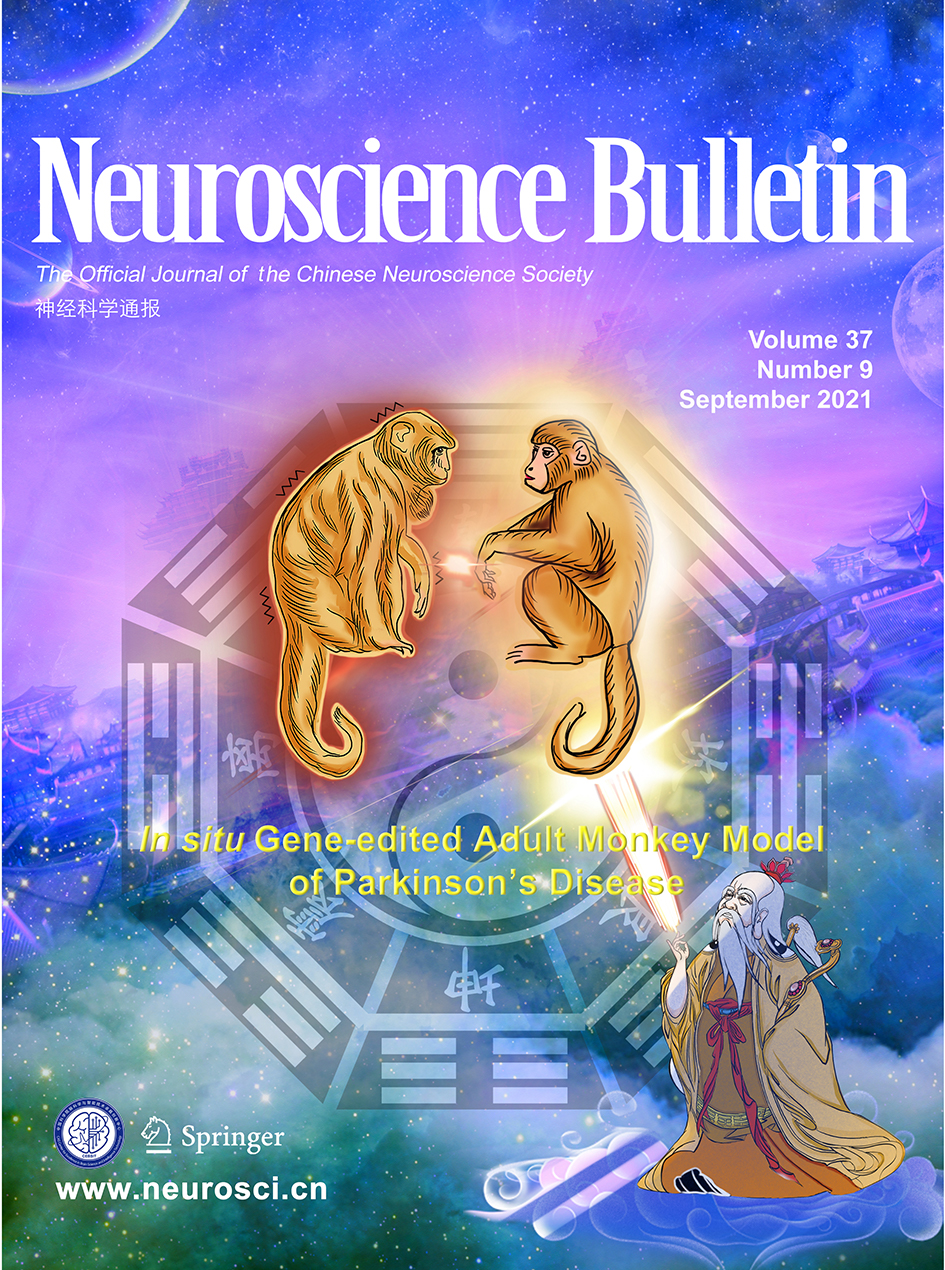Co-editing PINK1 and DJ-1 Genes Via Adeno-Associated Virus-Delivered CRISPR/Cas9 System in Adult Monkey Brain Elicits Classical Parkinsonian Phenotype
Hao Li • Shihao Wu • Xia Ma • Xiao Li • Tianlin Cheng • Zhifang Chen • Jing Wu1 • Longbao Lv • Ling Li6 • Liqi Xu • Wenchao Wang1 • Yingzhou Hu •
Haisong Jiang • Yong Yin • Zilong Qiu • Xintian Hu
2021, 37(9):1271-1288 [
Abstract] [
SpringerLink]
[PDF]
Growth Differentiation Factor-15 Produces Analgesia by Inhibiting Tetrodotoxin-Resistant Nav1.8 Sodium Channel Activity in Rat Primary Sensory Neurons
Wei Lin • Wen-Wen Zhang • Ning Lyu • Hong Cao • Wen-Dong Xu •
Yu-Qiu Zhang
2021, 37(9):1289-1302 [
Abstract] [
SpringerLink]
[PDF]
The ATP Level in the mPFC Mediates the Antidepressant Effect of Calorie Restriction
Qian Wang • Ying Kong • Song Lin • Ding-Yu Wu • Jian Hu • Lang Huang • Wen-Si Zang • Xiao-Wen Li • Jian-Ming Yang • Tian-Ming Gao
2021, 37(9):1303-1313 [
Abstract] [
SpringerLink]
[PDF]
Pinocembrin Promotes OPC Differentiation and Remyelination via the mTOR Signaling Pathway
Qi Shao • Ming Zhao • Wenwen Pei • Yingyan Pu • Mingdong Liu • Weili Liu • Zhongwang Yu • Kefu Chen • Hong Liu • Benqiang Deng • Li Cao
2021, 37(9):1314-1324 [
Abstract] [
SpringerLink]
[PDF]
Reduced Firing of Nucleus Accumbens Parvalbumin Interneurons Impairs Risk Avoidance in DISC1 Transgenic Mice
Xinyi Zhou • Bifeng Wu • Wenhao Liu • Qian Xiao • Wei He •
Ying Zhou • Pengfei Wei • Xu Zhang • Yue Liu • Jie Wang •
Jufang He • Zhigang Zhang • Weidong Li • Liping Wang •
Jie Tu
2021, 37(9):1325-1338 [
Abstract] [
SpringerLink]
[PDF]
Lateral Habenula Serves as a Potential Therapeutic Target for Neuropathic Pain
Yu Du • Yu-Xing Wu • Fang Guo • Feng-Hui Qu • Ting-Ting Hu •
Bei Tan • Yi Wang • Wei-Wei Hu • Zhong Chen • Shi-Hong Zhang
2021, 37(9):1339-1344 [
Abstract] [
SpringerLink]
[PDF]
Descending Modulation of Spinal Itch Transmission by Primary Somatosensory Cortex
Zi-Han Wu • Han-Yu Shao • Yuan-Yuan Fu • Xiao-Bo Wu •
De-Li Cao • Sheng-Xiang Yan • Wei-Lin Sha • Yong-Jing Gao •
Zhi-Jun Zhang
2021, 37(9):1345-1350 [
Abstract] [
SpringerLink]
[PDF]
Resolution of Inflammatory Pain by Endogenous Chemerin and G Protein-Coupled Receptor ChemR23
Ya-Kai Xie • Hao Luo • Xiao-Yun Qiu • Zhen-Zhong Xu
2021, 37(9):1351-1356 [
Abstract] [
SpringerLink]
[PDF]
A Frameshift Variant in the SEMA6B Gene Causes Global Developmental Delay and Febrile Seizures
Li Shu • Yuchen Xu • Qi Tian • Yuanyuan Chen • Yaqin Wang •
Hui Xi • Hua Wang • Neng Xiao • Xiao Mao
2021,37(9):1357-1380 [
Abstract] [
SpringerLink]
[PDF]
Residual Recurrence Risk of Ischemic Cerebrovascular Events: Elements and Implications
Jiejie Li • Zixiao Li • Tian-jie Lyu • Si Cheng • Yuehua Pu • Yongjun Wang
2021, 37(9):1361-1364 [
Abstract] [
SpringerLink]
[PDF]
Magnetic Resonance Imaging-Guided and Navigated Individualized Repetitive Transcranial Magnetic Stimulation for Cognitive Impairment in Schizophrenia
Xu-Sha Wu • Tian-Cai Yan • Xian-Yang Wang • Yang Cao •
Xiao-Fan Liu • Yu-Fei Fu • Lin Wu • Yin-Chuan Jin • Hong Yin •
Long-Biao Cui
2021, 37(9):1365-1369 [
Abstract] [
SpringerLink]
[PDF]
An Evolved Human-specific Epigenetic Mechanism for Cortical Expansion and Gyrification
Dan Li • Yunli Xie
2021, 37(9):1370-1372 [
Abstract] [
SpringerLink]
[PDF]
Targeting the Transnitrosylation Cascade Provides a Novel Therapeutic Strategy for Alzheimer’s Disease
Yi Liu • Gang Wu • Xiji Shu • Xiaochuan Wang
2021, 37(9):1373-1376 [
Abstract] [
SpringerLink]
[PDF]
Vasopressin Signaling Buffers Synaptic Metaplasticity in a Sex-specific Manner
Luodan Yang • Lorelei Tucker • Quanguang Zhang
2021. 37(9):1377-1380 [
Abstract] [
SpringerLink]
[PDF]
